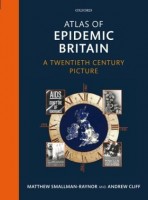 Authors: Matthew Smallman-Raynor and Andrew Cliff
Authors: Matthew Smallman-Raynor and Andrew Cliff
Publisher: Oxford University Press
Book Review by: Nano Khilnani
A book that covers epidemics in Britain for an entire century from 1901 to 2000, this is a unique look into history with large maps detailing which major diseases spread, and when, where, how and why they did. The word ‘epidemic’ comes from two Greek words: ‘demos’ meaning ‘people’ and ‘epi’ meaning ‘close to’. An epidemic in the medical field refers to an unusually high incidence of a particular disease.
What is disease? The word ‘disease’ literally means ‘dis-ease’ or the absence of ease, the authors write. It refers generally to any ailment, sickness or departure from sound health. More specifically, it could be a disorder in any body part (e.g. heart, lung, kidney) caused by chemical, microbiological or physical injury. Other causes of disease may be genetic or developmental in nature.
This book covers the contagions that occurred not only in the United Kingdom which includes Great Britain (consisting of England, Northern Island, Scotland and Wales) but the entire area known as the British Isles (that encompasses the UK, Ireland, the Channel Islands and the Isle of Man).
The huge importance of this book lies in our learning how and why millions of people perished and what we can do to prevent such mass deaths now and in the future. This is a one-of-a-kind book that combines medicine, disease control, geography and history.
The large-size (about 11” x 14”) of this book has provided ample space to present full-color and black-and-white book covers, charts, illustrations, images from microscopes, maps, photographs, posters, tables and other graphic items to easily convey information about the different diseases that afflicted vast numbers of people in the British Isles in the twentieth century.
While the present book covers diseases in the twentieth century, its predecessor covered those that prevailed in the nineteenth century and before. It consisted of two volumes – published respectively in 1891 and 1894 – of Charles Creighton’s A History of Epidemics in Britain, described by the authors as ‘monumental’ in scope, as they covered all the familiar infectious diseases known then, such as cholera, measles, scarlet fever, smallpox, typhus and whooping cough.
Charles Creighton MD, who lived between 1847 and 1927, wrote in this book about the diseases in the British Isles prevailing from 664 AD until the end of the nineteenth century. The book was described as ‘a great work, great in conception, in learning, in industry, in philosophic insight’ in an 1894 issue of the medical journal Lancet.
This atlas is organized into an Introduction (with two chapters) and three sections (with nine other chapters); a large References and author index for further study by readers; and an index for look-up purposes. Each chapter in each section presents a conclusion, which makes for easier absorption of the key points covered in the chapter.
The Introduction first presents and discusses the mapping of diseases in Britain; then presents Britain’s changing burden of disease, providing an international perspective.
Section I, with chapters three though six, covers the major infectious diseases in the 1901-45 period, which includes diphtheria, dysentery, enteric fever, influenza, malaria, measles, meningitis, poliomyelitis, scarlet fever, smallpox, streptococcal infections, tuberculosis, whooping cough and other diseases.
Section II, on the 1946-2000 period, has chapters seven through ten. Each of the first three chapters covers respectively the major bacterial diseases, the major viral diseases, and the birth of new plagues such as HIV/Aids. Discussion continues in this section on some of the diseases named above. It also takes up DPT (diphtheria, pertussis, tetanus) and MMR (measles, mumps, rubella). The fourth chapter in this section discusses research studies. Section III discusses diseases in Britain in the current – twenty-first – century.
This book – which provides a century of change in Britain’s history of epidemics – is truly one of a kind in scope and presentation. The authors Matthew Smallman-Raynor and Andrew Cliff have done extensive research to unearth facts on the history of diseases that plagued the British Isles in the 1901-2000 period. We applaud their valuable contributions to the growth of knowledge in this area, and urge readers to acquire this unique book.







